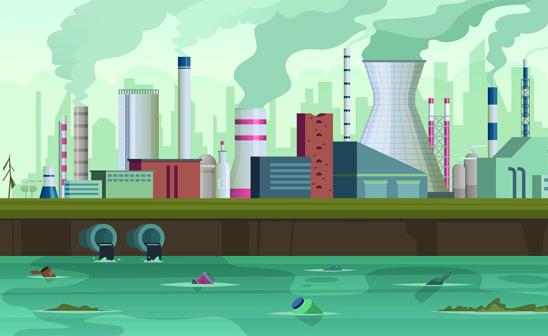New Study Explores the Effects of Neurotoxic Air Pollution in Early Life on Cognitive Development

The study — one of the first of its kind — focuses on the intersection of neighborhood effects research and environmental health epidemiology.
By Sarah Steimer
The study of concentrated poverty and its effects on kids and social mobility has been a sociological topic for a long time, but new research published in Science Advances is among the first to explore neighborhood effects on cognitive development that considers the mediating role of neurotoxic air pollution exposure in early life.
Lead researcher Geoffrey Wodtke, Associate Professor in the Department of Sociology, said he was drawn toward the intersection of neighborhood effects research and environmental health epidemiology by previous research showing socio-economic gaps in child development. Those gaps emerge as early as 6 months of age and definitely by 2 years old — meaning they're pretty firmly entrenched before kids even start school.
“If differences in neighborhood poverty matter for the emergence of those gaps, something has to be going on in those neighborhoods that is relevant for babies and toddlers and preschoolers,” he says “But most sociological theories of neighborhood effects focus on things like peer socialization, school quality differences, and so forth, which are mainly relevant for older kids.”
Research from a variety of disciplines points toward early childhood being a critical period, so the researchers sought to consider what differs between these neighborhoods that would have a relevant effect for such young children. That led Wodtke, who is also the Director of the Stone Center for Research on Wealth Inequality and Mobility, and his team to consider environmental health hazards, such as air pollution.
The researchers used data from the Early Childhood Longitudinal Study, Birth Cohort, from the U.S. Department of Education, which is a large, nationally representative sample of children born in 2001. The survey provides information about where kids live, in particular their zip code, which allowed the team to match that data with information about the socio-economic composition of their neighborhoods and other data on air quality from the Environmental Protection Agency.
The team found that living in a high-poverty neighborhood increases exposure to many different air toxics during infancy, that it reduces cognitive abilities measured later at age 4 by about one-tenth of a standard deviation, and that about one-third of this effect can be attributed to disparities in air quality.
“What's important is we provide some initial and relatively strong evidence that being born into a poor neighborhood harms early cognitive development, and this is at least partly due to exposure to neurotoxic air pollution,” Wodtke says.
He also noted some surprising results as well, as the causal process connecting neighborhoods to air pollution — and air pollution to cognitive ability — is more complex than the team initially expected. For instance, kids in poor neighborhoods are much more likely to be exposed to traffic-related pollution like nitrogen dioxide and carbon monoxide, but actually less likely to be exposed to ozone. “You have this complicated process where living in a poor neighborhood makes you more likely to breathe certain harmful things, but less likely to breathe other harmful things,” Wodtke says. “When I went into the study, I had more of a simple idea of what was going on: that poor neighborhoods are going to uniformly suffer from greater exposure to all different kinds of air pollution. But that wasn't exactly the case.”
As this is still a relatively immature area of research, Wodtke says we’re likely a ways removed from concrete policy proposals, but says that it does point toward one possible class of interventions that could mitigate neighborhood effects, and such regulations would clean up the air and reduce exposures to air pollution.
Wodtke also coauthored a similar study on the effects of concentrated poverty and environmental lead contamination on early childhood development, published in the journal Demography. The paper used blood-lead surveillance data collected by the Chicago Department of Public Health.
“Lead is a dangerous, neurotoxic heavy metal that is especially harmful for very young kids and is highly unequally distributed across poor neighborhoods with older housing, deteriorating lead paint, and older and potentially corroding lead plumbing,” Wodtke says. Poor neighborhoods also tend to be located closer to industrial facilities that emit lead into the air that settles on the ground where it stays indefinitely.
The study found that sustained exposure to disadvantaged neighborhoods reduces vocabulary skills during early childhood, and that this effect operates by way of a causal mechanism that involves lead contamination.
“What was surprising was just how big of a role lead seemed to play in the data I was analyzing,” Wodtke says.
 THE UNIVERSITY OF CHICAGO
THE UNIVERSITY OF CHICAGO


